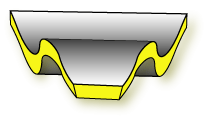|
|
|
Fold Systems: The Concepts of Profile Plane |
|
|
|
 |
|
|
The asymmetry of parasitic folds involves either a clockwise rotation (Z-shaped folds) or an anticlockwise rotation (S-shaped folds) of the folded surface. The asymmetry of parasitic folds change across fold hinges as S-shape folds occur in one limb and Z-shaped folds occur on the other. Therefore one can use this change to track down the position of large-scale fold hinges in region of poor exposures.
When doing this some caution should be exercised. In particular it is important to realise that the sense of fold asymmetry (S or Z) depends on the direction toward which the observation is made. The sketch on the right shows a parasitic fold. Looking from east to west the fold appears as a Z-shaped asymmetric fold. In contrast, when looking from west to east the fold appears as an S-shaped fold. This change in asymmetry is not the result of having crossed a fold hinge but simply the consequence of looking at the same parasitic fold in two different directions. To avoid any mistake, fold asymmetry should be determined looking toward the same direction, usually toward the plunge direction of the fold axis in plunging or reclined folds.
Another very common source of mistake is entrenched in the fact the 2D sections through 3D object can be extremely misleading in representing the true fold morphology. Indeed, a simple upright symmetric fold can appear as an appareent recumbent fold on a 2D vertical section cutting a angle to the fold axis. |
|
|
|
|
|
|
|
|
|
|